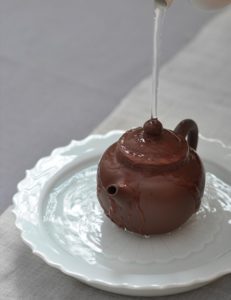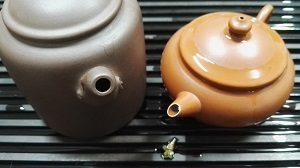Visit a Yixing store and it’s easy to feel overwhelmed by the wonderful selection of Zisha (‘purple clay’) teapots. Use this guide to understand which of these many variations in design is best for brewing your choice of tea. The taste of every type of Camellia Sinensis (with the exception of green tea and yellow tea) is enhanced by brewing in a quality Zisha teapot.
The basics – test the water

A fine quality entry-level Zisha pot starts at $100 and can easily cost $400 or more depending on design age, clay, artist, style and production methods. The more expensive pots are shaped by hand using wooden and bamboo tools to manipulate the clay into form. Marks indicating this technique as visible on the inside of the tea pot. Cheaper Yixing pots (often with intricate designs) are produced by slipcasting.*
Reputable vendors will allow you to test the porosity before making this large investment. You should feel absolutely comfortable asking to see the teapot in action. Note that the skin of a new Yixing tea pot should be smooth, but not glossy as it has not developed a smooth patina. The patina’s unique color and feel develops over time time due to organic tannins from the tea getting caught in the pores. Tannings and organic compounds in the tea interact with the iron in the clay to create an illustrious surface.
Here are the characteristics to evaluate: Visually the teapot should exhibit a consistent, uniform design. Begin by filling the interior and pouring water over the exterior of the pot to see if water is absorbed. Good quality Zisha is very porous. Filled with water, the spout and handle should feel balanced in your pouring hand. There should be a seamless fit between lid and body. The best way to test the quality of the fit is to pour. Water should promptly exit the spout. There should not be any drips from the edge of the lid. Properly designed spouts deliver a full stream of water in a parabolic curve that is smooth, sturdy and ends with a clean finish. Test to see if the water immediately comes to a stop when the air hole in the lid is covered while holding the pot in a normal pouring position.
Intermediate – suit your needs
Consumers willing to spend several hundred dollars for their teapot should select genuine teapot designs made of authentic Zisha clay. Many are not. When shopping online there is no way to authenticate the pot’s material by appearance, so Tea Journey discourages buying Zisha pots from unverified suppliers with vague return policies. Authenticating the most valuable Zisha pots can be complicated. Here are some advanced techniques to consider. Pour boiling water into the pot and let it sit for a few seconds, then empty the pot and sniff closely inside and out. Teapots made out of true Zisha should smell clean and earthy with no weird or pungent odors. A chemical smell indicates fillers, binders and coloring were mixed with cheap clay to make the pot look and feel like real Zisha.
Appearances can be convincing and the intricate design appealing. To determine the authenticity of the clay pour hot water over the teapot and closely observe how the water flows over the outside of the teapot. Natural Zisha clay has thousands of tiny pores that interfere with the flow of water along its surface. Water trapped in these minuscule pores pools which makes the flow uneven across the surface of genuine Zisha clay (see photo above). It will look dry as soon as the water passes. If the water flows evenly across the surface of the pot, then it is highly likely that the material is not authentic clay. Droplets of water indicate the clay has most likely been altered with chemicals, meaning it is a fake.
Brewing with Zisha
If you are new to gongfu style brewing, handling hot water in a delicate and potentially expensive teapot requires practice. The word “gongfu” literally means “achieving mastery or excellence via patient practice”. Making tea the “gongfu” way is all about mindfully controlling the variables of tea-making with precise and stable hand movements, to be rewarded with optimal flavor through multiple brews.
Start small
Beginners should start with a small teapot that holds 150 to 200 milliliters of water. This will serve a small group of 2-4. If you know that you will always serve a big group of at least 5 people, for family gatherings or business meetings, choose a pot that is at least 300 ml to make sure that everyone gets a full cup. The water-to-tea ratio is what distinguishes gongfu tea brew from the British tradition of brewing and pot or mug of tea. “Gongfu” uses relatively small vessels (150-250 ml) and a large quantity of loose leaves (5-7 grams), with an extremely short steeping time (a few seconds to a minute, depending on the type/grade of tea). Steeping higher grade teas in a mug for an extended period of time means that the liquid is fully saturated with all the aromas and flavors lumped together. Gongfu is a more refined presentation. The tea is decanted within a few seconds to prevent the kind of coarse-steeping typical of the West. By subjecting the tea to multiple rounds of steeping, the chemicals within the leaves are released in layers. This enables you to experience the distinct changes that vary with each steeping, similar to the appreciation of wine, coffee, and perfume.
How much retained heat does your choice of tea require?

The next consideration rests on whether your choice of tea requires a high degree of heat retention in the brewing process. Thick-wall pots are good for brewing teas that require higher temperatures. It is similar to why cast iron cookware is preferred in cooking certain dishes. Thin-wall pots are less common, but would be great for some black teas and white tea because they are made with leaves that are tender and benefit from faster dissipation of heat.
Shape: Slender vs. flat
Zisha are used to brew a single style of tea. Once that choice is made a buyer should consider the many different shapes created for every style of tea. Weaving functionality into design marks a transition from intermediate to advanced brewing. Since you only get one tea for one Yixing pot, knowing your preference in tea allows an informed decision when shopping for the best brewing gear. If you wish to brew large-leaf teas, such as puer, use a wider, fat body style with a large opening in the lid. The ample body provides room for the expansion of steeped leaves and it makes getting teas in and out easy. The ideal pot for brewing puer might not suit wulong, even though both require high water temperatures to unfurl the compressed or tightly curled leaves. If you want to brew aroma-rich teas such as tie guan yin wulong, choose a teapot that has a tall and slender body with a smaller lid opening, so as to trap the volatile aromatic compounds inside the tea liquor, ready to be released during the pour.
Advanced – Variations in style
Once you become familiar with the basics — selecting a favorite Zisha teapot can be as fun as finding the perfect engagement ring: How big of a center stone? What about the style of prong and shank? Should the ring include surrounding accents? Do you favor a minimalist design with a round-cut solitaire or a glamorous double-halo cushion-cut with cathedral shank setting? Your choice in teapots is revealing.
Similarly, you will find design elements in a Zisha teapot that truly resonate, reflecting your personality while matching the tea you love. Few Zisha potters start with a sketch. The craft is learned during a long apprenticeship. Artists favor precision in realizing their vision over premeditated engineering. At the consumer level, most pots conform to tried-and-true traditional geometric forms. It is only recently that custom-made teapots are gaining popularity.
Here are six components to consider in dreaming up your one-of-a-kind Zisha:
Infograph by: Iris Ma
* In slipcasting, a liquid clay body slip (usually mixed in a blunger) is poured into plaster moulds and allowed to form a layer, the cast, on the inside walls of the mould. The process usually takes at least 24 hours per piece. It gives very precise and consistent shapes, and is now the most common technique used for commercial mass-produced pottery, although it began as a technique for fine pottery, especially porcelain. According to Cult of Quality, “a real Yixing should not have any mold marks on the inside. Those on the outside will have been polished. There should be no stress marks around edges from a slurry mold; these stress marks can be seen when the teapot has a corner or a slighter curve, and the slurry didn’t fill the cast all the way, causing stretching while the clay was shrinking. These stress marks appear as small sets of lines oriented perpendicular to the direction of stretch. The inside of a Yixing should not be perfect and smooth; there should be scrapes and visible hand casting marks on the inside.”
Tea Market
Get More Value from Your Tea: BRU Maker One
+41794574278
Jacque's Organics
(647) 804-7263

Thank you for sharing your knowledge here. I thoroughly enjoyed all of your articles. Speaking of owning a decent zisha, do you have a reliable seller that you know of, either in the U.S or China that you would recommend?
Hi, I truly enjoyed reading your article.I do have a small collection of Zisha teapot.
Just wonder if you are able to identify their authenticity or you might know of a website
that you can refer me . Many thanks
There are hundreds of reputable dealers. The most important test is to inspect closely and douse with boiling water as described in the article. Dan
I’m so thankful to you for your article I came across while in search of my first authentic teapot. My only question is now how do I find an authentic handmade teapot from the US?
Hi, I bought a Yixing tea set at an auction can someone please authenticate this set ??
or give further information about it, period or so. as U would like to sell it. First I need to know what is it worth or the value of the set
I can send you pictures also I did the water test and look at the other specified features described on the Tea Journey page.
Thanks and regards Gérard